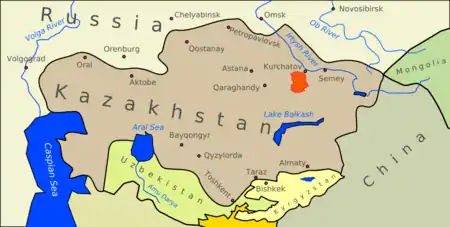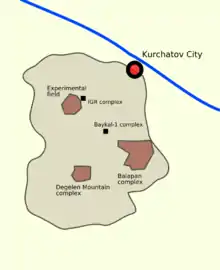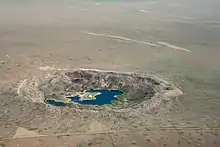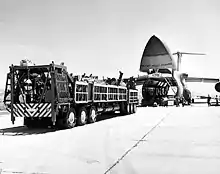Semipalatinsk Test Site
The Semipalatinsk Test Site (STS or Semipalatinsk-21), also known as "The Polygon", was the primary testing venue for the Soviet Union's nuclear weapons. It is located on the steppe in northeast Kazakhstan (then the Kazakh SSR), south of the valley of the Irtysh River. The scientific buildings for the test site were located around 150 km (93 mi) west of the town of Semipalatinsk (later renamed Semey), near the border of East Kazakhstan Region and Pavlodar Region with most of the nuclear tests taking place at various sites further to the west and south, some as far as into Karagandy Region.
| Semipalatinsk Test Site | |
|---|---|
| Near Kurchatov in Kazakhstan | |
 The 18,000 km2 expanse of the Semipalatinsk Test Site (indicated in red), attached to Kurchatov (along the Irtysh river), and near Semey, as well as Karagandy, and Nur-Sultan. The site comprised an area the size of Wales | |
| Coordinates | 50°07′N 78°43′E |
| Type | Nuclear test site |
| Area | 18,000 km2 (6,950 sq mi) |
| Site information | |
| Operator | Soviet Union |
| Status | Inactive |
| Site history | |
| In use | 1949 – 1991 |
| Test information | |
| Subcritical tests | not known |
| Nuclear tests | 456 (340 underground and 116 aboveground)[1] |
The Soviet Union conducted 456 nuclear tests at Semipalatinsk from 1949 until 1989 with little regard for their effect on the local people or environment. The full impact of radiation exposure was hidden for many years by Soviet authorities and has only come to light since the test site closed in 1991.[2][3]
From 1996 to 2012, a secret joint operation of Kazakh, Russian, and U.S. nuclear scientists and engineers secured the waste plutonium in the tunnels of the mountains.[4]
Since its closure, the Semipalatinsk Test Site has become the best-researched atomic testing site in the world, and the only one in the world open to the public.[5]
History


.jpg.webp)
The site was selected in 1947 by Lavrentiy Beria, political head of the Soviet atomic bomb project (Beria falsely claimed the vast 18,000 km² steppe was "uninhabited").[6][7] Gulag labour was employed to build the primitive test facilities, including the laboratory complex in the northeast corner on the southern bank of the Irtysh River. The first Soviet bomb test, Operation First Lightning (nicknamed Joe One by the Americans) was conducted in 1949 from a tower at the Semipalatinsk Test Site, scattering fallout on nearby villages (which Beria had neglected to evacuate). The same area ("the experimental field", a region 64 km (40 mi) west of Kurchatov city) was used for more than 100 subsequent above-ground weapons tests.
Later tests were moved to the Chagan River complex and nearby Balapan in the east of the STS (including the site of the Chagan test, which formed Chagan Lake). Once atmospheric tests were banned, testing was transferred to underground locations at Chagan, Murzhik (in the west), and at the Degelen Mountain complex in the south, which is riddled with boreholes and drifts for both subcritical and supercritical tests. After the closure of the Semipalatinsk labour camp, construction duties were performed by the 217th Separate Engineering and Mining Battalion (who later built the Baikonur Cosmodrome). Between 1949 and the cessation of atomic testing in 1989, 456 explosions were conducted at the STS, including 340 underground (borehole and tunnel) shots and 116 atmospheric (either air-drop or tower shots). The lab complex, still the administrative and scientific centre of the STS, was renamed Kurchatov City after Igor Kurchatov, leader of the initial Soviet nuclear programme. The location of Kurchatov city has been typically shown on various maps as "Konechnaya" (the name of the train station; now Degelen) or "Moldary" (the name of the village that was later incorporated into the city).
The Semipalatinsk Complex was of acute interest to foreign governments during its operation, particularly during the phase when explosions were carried out above ground at the experimental field. Several U-2 overflights examined preparations and weapons effects, before being replaced with satellite reconnaissance. The US Defense Intelligence Agency is said to have been convinced that the Soviets had constructed an enormous beam weapon station at a small research station located on the testing site.[8] This smaller research station, known to the Department of Defense as PNUTS (Possible Nuclear Underground Test Site) and the CIA as URDF-3 (Unidentified Research and Development Facility-3) was of great interest to American observers. After the fall of the Soviet Union in 1991, it was discovered that the mysterious URDF-3 was tasked with researching a nuclear thermal rocket similar to the US's NERVA.[9]
The site was officially closed by the President of the Kazakh Soviet Socialist Republic Nursultan Nazarbayev on 29 August 1991.[10]
Legacy
.jpg.webp)
The Soviet Union conducted its last tests in 1989.[11] After the Soviet Union collapsed in 1991, the site was neglected. Fissile material was left behind in mountain tunnels and bore holes, virtually unguarded and vulnerable to scavengers, rogue states, or potential terrorists. The secret cleanup of Semipalatinsk was made public in the 2010s.[12]
After some of the tests, radioactive material remained on the now abandoned area, including significant amounts of plutonium. The risk that material might fall into the hands of scavengers or terrorists was considered one of the largest nuclear security threats since the collapse of the Soviet Union. The operation to address the problem involved, in part, pouring special concrete into test holes, to bind the waste plutonium. In other cases, horizontal mine test holes were sealed and the entrances covered over. Finally in October 2012, Kazakh, Russian, and American nuclear scientists and engineers celebrated the completion of a secret 17-year, $150 million operation to secure the plutonium in the tunnels of the mountains.[4]
Large parts of the STS have opened up since 2014, and economic activity has resumed: mostly mining, but also agriculture and tourism. As with other areas affected by radioactivity, the lack of human interference has made the STS a haven for wildlife.[5]
Anti-nuclear movement
The anti-nuclear movement in Kazakhstan, "Nevada Semipalatinsk", was formed in 1989 and was one of the first major anti-nuclear movements in the former Soviet Union. It was led by author Olzhas Suleimenov and attracted thousands of people to its protests and campaigns which eventually led to the closure of the nuclear test site at Semipalatinsk in 1991.[13][14][15]
According to UNESCO, Nevada-Semipalatinsk played a positive role in promoting public understanding of "the necessity to fight against nuclear threats".[16] The movement gained global support and became "a real historical factor in finding solutions to global ecological problems".[16]
Health impacts

Studies conducted at Cambridge took blood samples from forty different families who lived in a district of Kazakhstan that were directly exposed at high levels to fallout from the Soviet bomb tests.[17] These studies concluded that individuals who had been exposed to the fallout between 1949 and 1956 had an approximate 80% increase in the Minisatellite regions of their DNA. The children of these individuals had 50% more mutations in their mini-satellite regions compared to their control counterparts.[17][18] Some health scientists are still not sure what the germline mutations mean for the individuals' health, but there is increasing evidence these mutations may increase genetic predisposition to certain diseases such as cardiovascular diseases.[19] There has also been evidence that increased levels of DNA mutation rates are correlated with prolonged radiation exposure.[20] A longitudinal study conducted over a 40-year span found a correlation between radiation fallout exposure and prevalence of solid tumors. The most frequent sites for solid tumors were the esophagus, stomach, lungs, breasts, and liver. These sites were found to have statistically significant increases in prevalence when compared to a control group. However some bodily sites had no significant difference in number: cervix uteri, kidney, rectum, and pancreas.[17] The study's data suggests that there is a link between exposure length, and amount, to overall and cancer mortality. Nonetheless the relationship between the level of radiation exposure and effect is still up for discussion.
The full impact of radiation exposure was hidden for many years by Soviet authorities. The general consensus of health studies conducted at the site since it was closed is that radioactive fallout from nuclear testing had a direct impact on the health of about 200,000 local residents. Specifically, scientists have linked higher rates of different types of cancer to post-irradiation effects. Likewise, several studies have explored the correlation between radiation exposure and thyroid abnormalities.[1] A BBC program claimed in 2010 that in the worst affected locations one in 20 children born were with genetic defects. British film-maker Antony Butts documented some of the genetic health impacts in his 2010 film After the Apocalypse.[21][22]
A recently-declassified CIA report provides a first-hand witness account of the immediate impacts of a nuclear test near Semipalatinsk in 1955. In this report, a source who was in the vicinity of a Soviet thermonuclear test in November 1955 describes experiencing loss of hearing, "the air...crackling up with pressure" as if the "air was tearing up," and the ground shaking.[23][24]
Site of the signing of the Central Asian Nuclear Weapon Free Zone treaty
Semipalatinsk was the site that Kazakhstan, Kyrgyzstan, Tajikistan, Turkmenistan, and Uzbekistan chose for the signing of the Central Asian Nuclear Weapon Free Zone on 8 September 2006, also commemorating the 15th anniversary of the test site's closing.
In popular culture
The 2014 film Ispytanie is a fictionalized account of the first Soviet nuclear test from the perspective of some of the local inhabitants.
See also
- Anti-nuclear movement in Kazakhstan
- List of nuclear reactors
- List of nuclear tests
- List of nuclear weapons tests of the Soviet Union
- Lists of nuclear disasters and radioactive incidents
- Nevada Test Site
- Novaya Zemlya Test Site
- Nuclear energy in Kazakhstan
- Operation Plumbbob
- Struan Stevenson
- Totskoye nuclear exercise
- Ulba Metallurgical Plant
References
- Togzhan Kassenova (28 September 2009). "The lasting toll of Semipalatinsk's nuclear testing". Bulletin of the Atomic Scientists.
- "Slow Death In Kazakhstan's Land Of Nuclear Tests". RadioFreeEurope/RadioLiberty. 2011-08-29. Retrieved 2015-08-31.
- "Russia Covered Up a Nuclear Fallout Worse Than Chernobyl, Confidential Report Reveals" 27 March 2017
- Plutonium Mountain: Inside the 17-Year Mission to Secure a Legacy of Soviet Nuclear Testing, Eben Harrell & David E. Hoffman, Belfer Center for Science and International Affairs, Harvard University, 15 August 2013, accessed 21 August 2013
- "Semipalatinsk Test Site: How to Visit, History and Future | Caravanistan". Caravanistan. Retrieved 2018-02-01.
- Brummell, Paul (2008). Kazakhstan. Bradt. p. 241. ISBN 978-1-84162-234-7.
- Taylor, Jerome (10 September 2009). "The world's worst radiation hotspot". The Independent. London. Retrieved 21 July 2011.
- "Satellite photo of suspected Soviet beam weapon installation", Aviation Week & Space Technology (via PBS)
- Richelson, Jefferey (2002). The Wizards of Langley. Boulder: Westview Press. ISBN 0-8133-4059-4.
- Norris, Robert S. (January–February 1992). "The Soviet Nuclear Archipelago". Arms Control Today. Arms Control Association. 22 (1): 27. JSTOR 23624674.
- Duff-Brown, Beth. "The lasting toll of Semipalatinsk's nuclear testing". Bulletin of the Atomic Scientists. Retrieved March 6, 2016.
- Duff-Brown, Beth. "Into Thin Air: The Story of Plutonium Mountain". Bulletin of the Atomic Scientists. Retrieved August 20, 2013.
- World: Asia-Pacific: Kazakh anti-nuclear movement celebrates tenth anniversary BBC News, February 28, 1999.
- Matthew Chance. Inside the nuclear underworld: Deformity and fear CNN.com, August 31, 2007.
- Krech III, Shepard; Merchant, Carolyn; McNeill, John Robert, eds. (2004). Encyclopedia of World Environmental History. 1: A–E. Routledge. pp. 70–71. ISBN 978-0-415-93733-7.
- "Kazakhstan - Audiovisual documents of the International antinuclear movement "Nevada-Semipalatinsk"". Portal.unesco.org. Retrieved 18 March 2019.
- Bauer, Susanne; Gusev, Boris I.; Pivina, Ludmila M.; Apsalikov, Kazbek N.; Grosche, Bernd (2005-01-01). "Radiation Exposure Due to Local Fallout from Soviet Atmospheric Nuclear Weapons Testing in Kazakhstan: Solid Cancer Mortality in the Semipalatinsk Historical Cohort, 1960-1999". Radiation Research. 164 (4): 409–419. doi:10.1667/rr3423.1. JSTOR 3581526.
- Stone, Richard. "DNA Mutations Linked to Soviet Bomb Tests". Jstor.org. JSTOR 3076055.
- Grosche, Bernd; Lackland, Daniel T.; Land, Charles E.; Simon, Steven L.; Apsalikov, Kazbek N.; Pivina, Ludmilla M.; Bauer, Susanne; Gusev, Boris I. (2011-01-01). "Mortality from Cardiovascular Diseases in the Semipalatinsk Historical Cohort, 1960-1999, and its Relationship to Radiation Exposure". Radiation Research. 176 (5): 660–669. doi:10.1667/rr2211.1. JSTOR 41318233. PMC 3866702. PMID 21787182.
- Dubrova, Yuri E.; Bersimbaev, Rakhmet I.; Djansugurova, Leila B.; Tankimanova, Maira K.; Mamyrbaeva, Zaure Zh.; Mustonen, Riitta; Lindholm, Carita; Hultén, Maj; Salomaa, Sisko (2002-01-01). "Nuclear Weapons Tests and Human Germline Mutation Rate". Science. 295 (5557): 1037–1037. doi:10.1126/science.1068102. JSTOR 3076101.
- "Life after nuclear testing". BBC World Service. Retrieved 19 February 2017.
- Butts, Antony (13 May 2011). "After the Apocalypse".
- Burr, William (6 April 2018). "CIA Debriefed Soviet H-Bomb Eye-Witness in 1957".
- "The National Security Archive". Nsarchive2.gwu.edu. Retrieved 18 March 2019.
External links
| Wikimedia Commons has media related to Semipalatinsk Test Site. |
- National Nuclear Center of Kazakhstan website
- The Nuclear Threat Initiative's page on the STS
- nuclearweaponarchive.org/ on the Soviet nuclear program
- Documentary about the tests and their effects on the populace
- Short documentary series "My home: nuclear base Semipalatinsk-21"
- Panoramic photos and videos of the test site